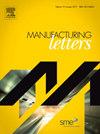使用耦合平滑粒子流体力学和有限元法建立调制刀具路径车削模型
IF 1.9
Q3 ENGINEERING, MANUFACTURING
引用次数: 0
摘要
本文介绍了用于调制刀具路径(MTP)车削的全尺寸三维耦合平滑粒子流体力学(SPH)和有限元模型。所开发的加工模型证明了刀具调制运动导致的断屑机制。相比之下,在相同加工条件下对传统车削的模拟则预测出了长的连续切屑。模拟预测的切削力与基于瞬时切屑厚度的机械力模型进行了验证。这项工作拓展了加工模拟的能力,通过全尺寸真实模拟来预测复杂的加工现象,如 MTP 车削。令人鼓舞的模拟结果显示了研究更复杂现象的潜力,如评估刀具路径调制参数、模拟超声波加工和研究加工稳定性。本文章由计算机程序翻译,如有差异,请以英文原文为准。
Modeling modulated tool path turning using coupled smoothed particle hydrodynamics and finite element method
This paper describes a full-scale, three-dimensional coupled smoothed particle hydrodynamics (SPH) and finite element model for modulated tool path (MTP) turning. The chip breaking mechanism due to modulated motion of the tool is demonstrated by the developed machining model. In contrast, the simulation of conventional turning with the same machining conditions predicts long continuous chips. The cutting force predicted by the simulation is validated with a mechanistic force model based on the instantaneous chip thickness. This work expands the capabilities of machining simulations to predict complex machining phenomena such as MTP turning through a full-scale realistic simulation. The encouraging simulation results show the potential to study more complex phenomena, such as evaluating the parameters of tool path modulation, simulating ultrasonic machining, and studying machining stability.
求助全文
通过发布文献求助,成功后即可免费获取论文全文。
去求助
来源期刊

Manufacturing Letters
Engineering-Industrial and Manufacturing Engineering
CiteScore
4.20
自引率
5.10%
发文量
192
审稿时长
60 days
 求助内容:
求助内容: 应助结果提醒方式:
应助结果提醒方式:


